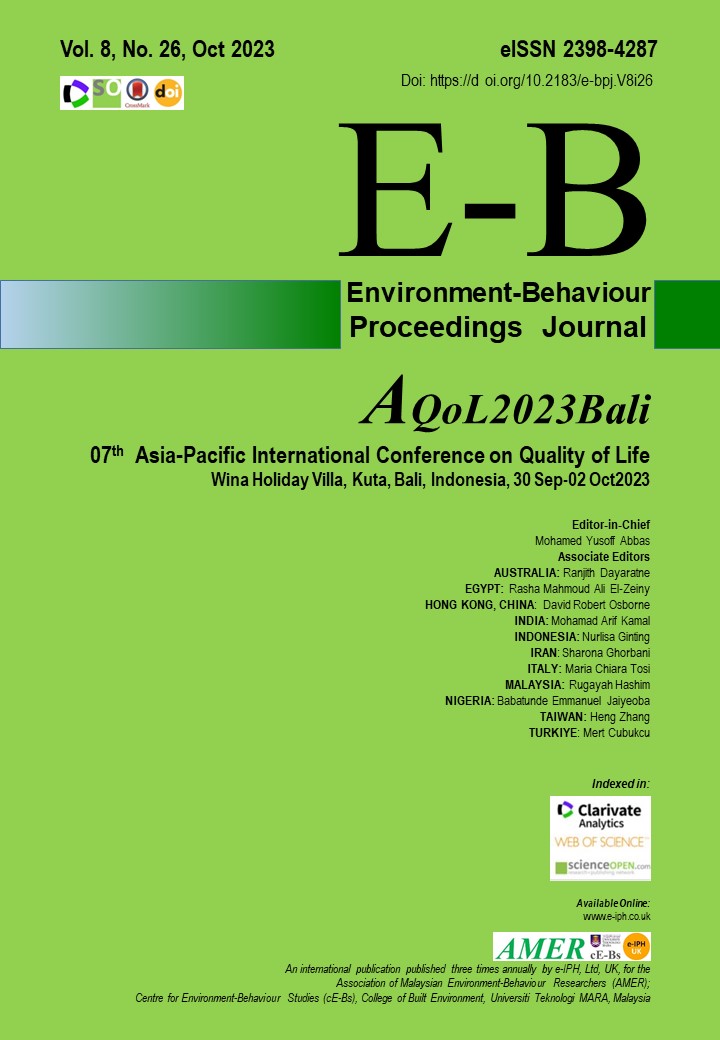Purchase Intention for Halal Cosmetic Product Among TikTok Application Users in Johor
DOI:
https://doi.org/10.21834/e-bpj.v8i26.5137Keywords:
Purchase, Intention, Halal, CosmeticAbstract
The demand for halal cosmetic products among the 2.0 billion Muslim consumers is growing internationally. This paper aims to identify the influence on attitude, subjective norms, perceived behavioral control, and knowledge towards the intention to purchase halal cosmetic products among consumers. A total of 100 questionnaires were distributed to TikTok users in Johor. The findings indicated that all variables positively influenced purchase intention of halal cosmetic products. This study also provides further insights into potential marketing strategies by halal cosmetic product manufacturers and the prospective halal cosmetic industry in Malaysia.
References
Ajzen, I. (1985). From Intentions To Actions: A Theory Of Planned Behaviour. In Action Control (Kuhl J. Be). Springer, Berlin, Heidelberg: SSSP Springer Series In Social Psychology. DOI: https://doi.org/10.1007/978-3-642-69746-3_2
Ajzen, I. (1988). Attitudes, Personality and Behavior. Chicago: IL: Dorsey.
Ajzen, I. (1991). The theory of planned behavior. Organizational behavior and human decision processes, 50(2), 179-211. DOI: https://doi.org/10.1016/0749-5978(91)90020-T
Ajzen, I. (2002). Perceived Behavioral Control, Self-Efficacy, Locus of Control and The Theory of Planned Behaviour. Journal Of Applied Social Psychology, 32(4), 665–683. DOI: https://doi.org/10.1111/j.1559-1816.2002.tb00236.x
Ajzen, I., (2002). Residual effects of past on later behavior: Habituation and reasoned action perspectives. Personality and Social Psychology Review, 6(2): 107-122. DOI: https://doi.org/10.1207/S15327957PSPR0602_02
Ajzen, Icek, & Driver, B. . (1992). Application of The Theory of Planned Behaviour to Leisure Choice. Journal of Leisure Research, 185–204. DOI: https://doi.org/10.1080/01490409109513137
Akmal. (2021). Research on Halal Certification in Indonesia. Journal of Islamic Economics Literatures, 2(2). https://doi.org/10.58968/jiel.v2i2.57 DOI: https://doi.org/10.58968/jiel.v2i2.57
Asa, R.S., & Azmi, I.M. (2017). The concept of Halal and Halal food certification process in Malaysia: issues and concerns.
Azmawani, A. R., Ebrahim, A., & Suhaimi, A. R. (2015). Consumers and Halal Cosmetic Product-Knowledge, Religiosity, Attitude and Intention. Journal of Islamic Marketing, 1, 148–163. https://doi.org/10.1108/JIMA-09-2013-006 DOI: https://doi.org/10.1108/JIMA-09-2013-0068
Azmi, A., Muslim, A., & Zaidi, I. (2010). The perception to choose Halal Cosmetics products: An empirical study for Malaysian consumer. In ICBME.
Davies, J., Foxal, R. G., & Pallister, J. (2002). Beyond the Intention-Behaviour Mythology: An Integrated Model of Recycling. Marketing Theory, 2(1), 29–113. DOI: https://doi.org/10.1177/1470593102002001645
Euromonitor Intenational. (2012). Market Research On Consumer Products, Commercial Industries, Demographics Trends And Consumer Lifestyles In Malaysia. Retrieved December 13, 2022, from https://www.euromonitor.com/malaysia
European Commission. (2015). Glossary and Acronyms Related To Cosmetics Legislation.
Guthrie, M., Kim, H., & Jung, J. (2008). The effects of facial image and cosmetic usage on perceptions of brand personality. Journal of Fashion Marketing and Management: An International Journal, 12(2), 164–181. https://doi.org/10.1108/13612020810874863 DOI: https://doi.org/10.1108/13612020810874863
Halal Journal. (2008). The Halal Journal | The Magazine for the Global Halal Market. The Halal Journal Business,Lifestyles and Trends. Retrieved from http://www.halaljournal.com/
Hashim, N.S., & Mohd Nor, A.R. (2022). The Benefit Of Halal Certificate Application From Small And Medium Industries Perspective. Journal of Islamic Philanthropy and Social Finance. DOI: https://doi.org/10.24191/JIPSF/v4n22022_102-112
Hunter, M. (2012). The Emerging Halal Cosmetic And Personal Care Market. Retrieved from https://www.slideshare.net/Murray58/the-emerging-halal-cosmetic-and-personal-care-market
Iranmanesh, M., Mirzaei, M., Hosseini, S. M. P., & Zailani, S. (2019). Muslims’ willingness to pay for certified halal food: an extension of the theory of planned behaviour. Journal of Islamic Marketing. DOI: https://doi.org/10.1108/JIMA-03-2018-0049
Jung, J., & Lennon, S. J. (2003). Body Image, Appearance, Self-Schema and Media Images. Family and Consumer Sciiences Journal, 32(1), 27–51. https://doi.org/10.1177/1077727X03255900 DOI: https://doi.org/10.1177/1077727X03255900
Kamaruzaman, K. . (2009). Halal Cosmetics: Between Real Concerns And Plain Ignorance. The Halal Journal Business,Lifestyles and Trends. Retrieved from http://halaljournal.com
Kim, H. ., & Chung, J. (2011). Consumer Purchase Intention For Organic Personal Care Products. Journal of Consumer Marketing, 28(1), 40-47. DOI: https://doi.org/10.1108/07363761111101930
Kumar, S., Massie, C., & Dumonceaux, M. D. (2006). Comparative innovative business strategies of major players in cosmetic industry. Industrial Managgement and Data Systems, 3(285–306). DOI: https://doi.org/10.1108/02635570610653461
Krueger, N. (2000). The Impact of Prior Entrepreneurial Exposure on Perceptions of New Venture Feasibility and Desirability. Entrepreneurship Theory and Practice, 18(1), 5–21. DOI: https://doi.org/10.1177/104225879301800101
Lada, S., Harvey Tanakinjal, G., & Amin, H. (2009). Emerald Article: Predicting intention to choose halal products using theory of reasoned action. International Journal of Islamic and Middle Eastern Finance and Management, 2(1), 66–76. https://doi.org/10.1108/17538390910946276 DOI: https://doi.org/10.1108/17538390910946276
Liao, S.-H., Hsieh, C.-L., & Huang, S.-P. (2008). Mining product maps for new product development. Expert Systems With Application, 34, 50–62. https://doi.org/10.1016/j.eswa.2006.08.027 DOI: https://doi.org/10.1016/j.eswa.2006.08.027
Liobikiene, G., & Bernatoniene, J. (2017). Why Determinants of Green Purchase Cannot Be Treated Equally? The Case of Green Cosmetics: Literature Review. Journal of Clean Production, 162, 109–120. DOI: https://doi.org/10.1016/j.jclepro.2017.05.204
Miller, K. (2005). Communications theories: perspectives, processes, and contexts. New York: McGraw Hill.
Mir, Mohammad Seyed Danesh Chavosh, Alireza Nahavandi, Mehrzad. (2010). In IEEE International Conference On Advanced Management Science 2010. https://doi.org/10.1109/ICAMS.2010.5553232 DOI: https://doi.org/10.1109/ICAMS.2010.5553232
Nash, R., Fieldman, G., Hussey, T., Lé, J.-L., Veˆ, V., & Pineau, P. (2006). Cosmetics: They Influence More Than Caucasian Female Facial Attractiveness. Journal of Applied Social Psychology 36. Retrieved from https://pdfs.semanticscholar.org/252d/59ee2958557f633354ae5420cd1fe944c97e.pdf DOI: https://doi.org/10.1111/j.0021-9029.2006.00016.x
Nunnally, J.C., Bernstein, I.H. (1994). Psychometric Theory. New York: McGraw-Hill.2(4), 1-11.
Rudd, N. A., & Lennon, S. J. (2000). Body Image And Appearance Management Behaviors In College Women. Clothing And Textiles Research Journal, 18(3), 152–162. https://doi.org/10.1177/0887302X0001800304 DOI: https://doi.org/10.1177/0887302X0001800304
Sheppard, B.H, Hartwick, J., & Warshaw, P. (1988). The Theory Of Reasoned Action: A Meta-Analysis of Past Research With Recommendations For Modifications And Future Research. Journal of Consumer Research, (15), 325–343. DOI: https://doi.org/10.1086/209170
Downloads
Published
How to Cite
Issue
Section
License
Copyright (c) 2023 Noreen Noor Abd Aziz, Mohd Hafizan Musa, Rusnani Mohamad Khalid, Shaherah Abdul Malik, Nurliana Nasution

This work is licensed under a Creative Commons Attribution-NonCommercial-NoDerivatives 4.0 International License.





